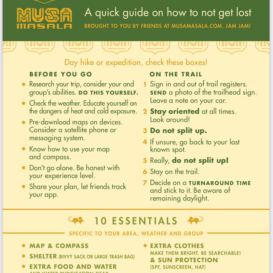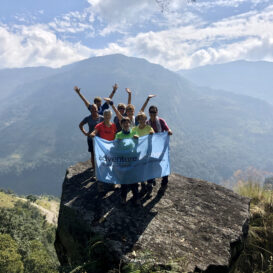Musa Masala welcomes 2022 with a topic we think all of us can relate to, resilience. What does it mean to you? Very different things at very different times, we think. Tamar Izcovich returns with a look at resilience that stopped us cold, and started us thinking. How we speak to others about this and what others are going through should always run through how we speak to friends, family and patients. This story will change our approach, and we hope it helps you as well.
Thank you, Tamar. Your posts are always a lesson in how we move through life. Jam Jam!!
Photo credit: All photos featured below are credited to Jesse L. Summers, and feature Tamar and friends on the Laugavegur Trail in Iceland.
What I Learned About Resilience on an Icelandic Trek, by Tamar Izcovich
What do you think of when you hear the word resilience? I imagine a string and no matter how hard you pull, it doesn’t break but rather gets stronger as it tightens. I picture a brick wall that even the strongest hammer can’t penetrate.
Throughout my career as a Social Worker I have been taught that being resilient means that a person is strong and capable, it’s the “anti-trauma” mechanism. Resilience helps children that face Adverse Childhood Experiences thrive, learn and develop. It’s what keeps us going under really challenging circumstances.
In the U.S., we tend to celebrate resilience. We congratulate individual success of being able to “pull yourself up by your bootstraps.” Resilience by this definition comes from within and it is up to the individual to draw resilience from internal resources.

I would like to make the case that resilience is not a one-person show but rather a relational endeavor.
If you’ve read my previous posts, you’d know by now that I am an avid hiker and often learn life lessons on treks. I learned my lesson about resilience on the Laugavegur Trail in Iceland…
We were so excited to travel to Iceland, us four. With a backpack full of dehydrated food and some warm layers, we were ready to brave the Icelandic wilderness! If you want to test your resilience, the Laugavegur Trail is the one for you; imagine 3-4 days of unpredictable weather-you can have a blizzard one day and sun the next, steep climbs, volcanic terrain and river crossings just to name a few of the many obstacles you may face.

In previous trails it was the terrain that taught me a lesson. In Nepal I learned my lessons from loose rocks, in the Canadian Rockies I learned it from the narrow pathways of the mountain. But in Iceland I learned it from the people I was with. We had just gotten past a blizzard, we were terrified we would get lost, we made it to the hut and all four of us exhaled in unison: “we made it.” We were brave and resilient, we survived! We parked ourselves at a table and did not move for five hours. As we sat there laughing, defrosting, telling our tale of heroism we met a solo trekker who would hike with us the next day.
Nature has healing elements to it. All of the self help books and wellness journals suggest that nature can help reduce stress. People have turned to nature for answers for centuries. There is wisdom in the mountains; it is not surprising that some cultures view mountains as sacred. Throughout my adulthood I have gone back to nature again and again to discover different parts of myself. The solo trekker was on one such journey. As we walked along the trail we learned of his tragic story of loss, of recently becoming a widower at a very young age. As we walked and as I listened I responded by saying, “you are so resilient.” I thought to myself, Tamar, you nailed it! You figured out after 12 years of practicing Social Work how to approach a grieving person. I was expecting him to say, “thank you for your very kind words.”

He didn’t say that.
What he did say changed my view of resilience forever. He responded: “I don’t want to be resilient anymore.” I choked, I thought I said the right thing. And then I started to unpack what I heard.
What I came to realize was that for him, and for so many people going through trauma and hardship, the idea of resilience puts the onus on that individual to bounce back. It’s hard work to be strong. Being resilient means that there is an expectation that grief or sadness or burnout will just disappear and we will be ok. But, what if it’s not that simple?
The idea of resilience can invalidate a person’s individual process and diminish the strength that people get from their community of support.

What if instead I had said: “You are practicing self compassion and grace by taking this solo trip and reconnecting with nature, you are connecting with people and showing your vulnerability. That is powerful and I hope it feels healing for you.”
People are strong, people are capable. We survive, that is what we do and that is resilience. But we do not have to do it alone or bounce back. The solo trekker, I imagine, was changed by his experience of loss; he didn’t bounce back but rather evolved into a new version of himself. The same way so many of us evolved into new versions of ourselves during the pandemic.
So I invite you to join me on a journey of self acceptance, grace and self compassion. When you are done reading this, reach out to a friend, check in and know that you never have to trek through life alone. And instead of bouncing back? Honor the strength you have and let whatever journey you are on show you the wisdom. You will end up exactly where you are supposed to be…at your own pace and in your own time.

Tamar Izcovich is a clinical social worker with a private practice in NYC. She is an avid hiker and is always up for an adventure outdoors. To learn more, check out Tamar’s previous posts, “Traveling Solo: Lessons Learned From Loose Rocks in the Himalayas” and “How a Social Worker Reclaimed Herself Through Nature During the Pandemic.”
Resources:
- https://www.cdc.gov/violenceprevention/aces/index.html
- https://wildlandtrekking.com/blog/backpacking-the-laugavegur-trail-in-iceland/
- https://trauma-recovery.ca/resiliency/what-is-resiliency/
- How to Build Resilience in Midlife – The New York Times (nytimes.com)













